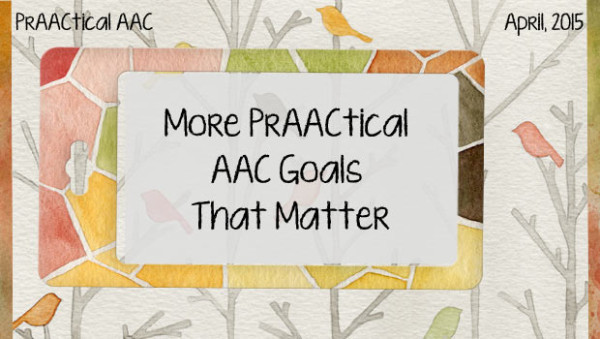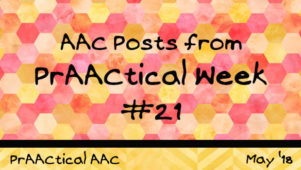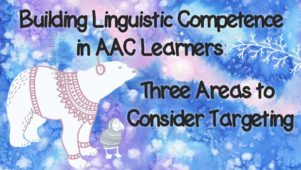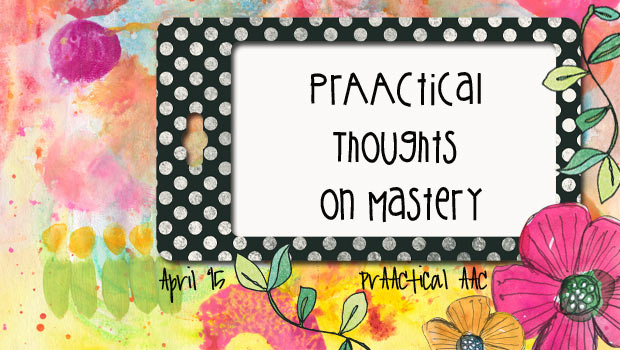More PrAACtical AAC Goals That Matter

While we may play a variety of roles, a commonality among those of us on teams serving individuals with AAC needs is that we often struggle with developing goals that are meaningful. Let’s work together to develop a list of potential goals that we can reflect on as we work with our clients and their families on a plan for becoming more competent communicators. There are two sections in this post: Qualifiers (for information applying to all goals) and Goal Areas (for actual goals). This is not meant to be a comprehensive list but rather a starting point for a collaborative document. Please join the effort by adding goals in the comment area below or reaching out using our contact form.
SECTION 1: QUALIFIERS
- Each goal can be prefaced with a description of the communicator’s AAC system or the elements of that system can be named.
- Terms used in this document
- Prestored Message: An utterance that was pre-assembled by someone other than the communicator; Can be on a voice-output device or no-tech communication aid. For example, a single button or cell that says “Hi, how are you?’” or “I want” or “I pledge allegiance to the flag of the….”
- Sentence: An utterance assembled by the communicator that has at least 2 words For example, a sentence put together by the communicator with these single words: “I” + “want” + “more” + “music.”
- Contextually-appropriate: Conceptually related to the activity or topic at hand
- Meaningful context: Event, exchange, or activity in which the communicator sees relevance, value, or meaning
- Linguistically-based AAC/communication aid: A no-tech, low-tech, or high-tech communication tool which has the following characteristics: a) more single word buttons/cells that longer message buttons/cells; b) rich pool of core words; c)ability to modify word forms; d) organized in a fashion that allows for further language growth.
- If independence is not the target level of performance, specify the level of assistance (e.g., partial prompts; full assistance).
- Specify the context to ensure appropriate implementation (e.g., in meaningful contexts; in daily living routines; in regular classroom activities).
- Specify the level, such as in structured tasks, in unstructured activities, or natural conversation.
- Specify the frequency to ensure adequate implementation (e.g., at least once per activity; 8-10 times/day; in every class period)
- Criterion can be specified based on assessment or baseline data.
- Consider some goals that focus on generalizing skills that the learner uses in structured situations (such as a defined therapy task) to a variety of more functional activities throughout the day.
- Consider embedding instructional strategies, such as aided language input, into the goal.
SECTION 2: GOAL AREAS
Expressive Language
Using Prestored Messages (i.e., multiple words/sentences on one cell/button; E.g., a button with “I want music”)
- Request a turn using prestored messages (e.g., “Hey, don’t forget me! I want a turn.”)
- Request desired objects/actions using prestored messages (e.g., “Turn the page, please” or “I want more”)
- Protest (or reject) undesired objects/actions/activities using prestored messages (e.g., “No, thank you. I don’t like that.”)
- Gain attention using prestored messages (e.g., “Excuse me. I need you for a minute.” “Look at this!”)
- Express a repeated line in a book, chant, or song (e.g., “All around the town!” “Clean up, clean up, everybody, everywhere”)
- Use greetings appropriate to the context (e.g., “Hello” “See you later”)
- Show off (e.g., “Look at me!” “I made it.”)
- Make a contextually-appropriate comment (e.g., “That’s just crazy!”)
- Tell about a prior or planned event (e.g., “We played Hungry Hippos in speech today!” “Jenna’s class is having a pizza party on Friday.”)
- Tell a personal narrative (Note: this can be prestored in one cell/button or distributed across several)
- Retell a story/event (Note: Can be prestored in 1 cell/button or distributed across several)
- Ask a question (e.g., “What’s that?” “What do you think?”)
- Express agreement or disagreement (e.g., “That’s right.” “I don’t think so.”)
- Give directions (e.g., “Red Group, line up” “Put it in my backpack, please.”)
- Use interjections (e.g., “Awesome job!” “No way!” “Wow! That’s crazy!”
- Use introductory messages (e.g., “Hi. How are you?” “Good to see you”)
- Use continuers (e.g., “I see.” “Hmm. That’s interesting.” “Okay”)
- Using termination messages (e.g. “Okay, see you later.” “I gotta run.”)
- Provide partner instructions (e.g., “It’s going to take me a minute. Please hang with me.” “Say each word as I point to it. If you’re wrong, I’ll shake my head and show you the right one.” “Ask me yes/no questions.”
- Advocate by giving feedback to partners (e.g., “That was helpful/unkind/unnecessary.” “Check my IEP.”)
Using Single Words That Can be Combined into Sentences (i.e., 1 word per cell/button; e.g. I+want+music=”I want music”)
- Given an array of preferred activities/objects/people, request a desired activity/object
- Given a field of ___ to ___ options (some preferred, some non-preferred), choose a preferred object/activity/person
- Request recurrence with single words (e.g., “more,” “again”) or short sentences (e.g., “more tickle,” “Read it again.”)
- Use short sentences to request preferred objects, actions/activities, or people
- Use short sentences to request help or attention
- Use short sentences to protest or reject undesired objects, actions/activities, or people
- Use contextually-appropriate action + object sentences (or agent + action + object sentences)
- Use contextually-appropriate agent + action sentences
- Use contextually-appropriate action + modifier sentences
- Use contextually-appropriate descriptors/modifiers/attributes in sentences
- Use contextually-appropriate prepositions and locatives in sentences
- Use subject pronouns correctly (e.g., (I, you, we, it)
- Use object pronouns correctly (e.g., me, her, us, them)
- Use indefinite pronouns correctly (e.g., all, another, someone, anybody)
- Use time-related words(e.g., ‘yesterday’, ‘now’, ‘soon’, ‘later’)
- Ask relevant ‘What’ questions or ‘What doing’ questions
- Ask relevant ‘Where’ questions
- Ask relevant ‘When’ questions
- Ask relevant ‘Why’ questions
- Ask relevant ‘How’ questions
- Request clarification (e.g., “Can you explain?”“Huh?” “What did you say?”)
- Ask relevant partner-focused questions (e.g., “What do you think?” “How was your weekend?” “What’s new?”)
- Use adjectives correctly to modify nouns based on color, size, amount, shape, and temperature (e.g., warm, tiny, bright, round)
- Use adjectives and adverbs correctly to modify nouns based/verbs on distance and time (e.g., far, sometimes, early, never, short, always, immediately)
- Respond to ‘What’ and ‘What doing’ questions with appropriate answers
- Respond to ‘Where’ questions with appropriate answers
- Respond to ‘When’ questions with appropriate answers
- Respond to ‘Why’ questions with appropriate answers
- Respond to ‘How’ questions with appropriate answers
- Respond to ‘yes/no’ questions to denote choice
- Respond to ‘yes/no’ questions to provide information
- Tell or retell a story with ____ number of critical elements
- Take several turns in a conversation
- Construct utterances about future events
- Construct utterances about current events
- Construct utterances about past events
- Use non-literal language (idioms, figurative language) appropriately
- Request an explanation or elaboration
- Use existing vocabulary to describe new word/concept
- Use at least __ new words per week
- Use correct morphological endings for verb conjugations and tenses (e.g., I am, you are; I am, I was)
- Use modal and auxiliary verbs (e.g., could, would, may, might) correctly
- Use words to indicate spatial locations (e.g., in, on, over, above) correctly
- Use words to indicated spatial relationships (e.g., with, next to, between, among ) correctly
- Use coordinating conjunctions (e.g., and, for, but, or) correctly
- Use subordinating conjunctions (e.g., because, while, though, since, after, although)correctly
- Initiate interaction
- Respond appropriately to partner-initiated communication
- Maintain conversations with acknowledgements (‘Cool,” “So interesting”)
- Maintain conversations by providing new information about the topic
- Re-direct the topic of conversation using cohesive messages (e.g., “That reminds me of…” “I forgot to tell you about…” “I remember…” “Another thing that…”)
- Use topic setters to alert partner of the topic/subject
- Terminate conversation using socially-appropriate language
- Complain or vent about a situation
- Use polite social forms (i.e, “please”, “thank you”)
- Compliment others about concrete attributes (e.g., “I like your hair.” “Nice dress”) or abstract characteristics (e.g., “You’re so nice!” “That was a smart thing to ask.”)
- Respond to requests for clarification by rephrasing misunderstood messages
- Respond to requests for clarification by repeating misunderstood messages
- Tell appropriate jokes or humorous anecdotes in social interactions
- Provide relevant reasons and rationales
- Convince or persuade with logical reasoning
- Make predictions
- Offer alternative solutions to problems
- Use descriptive language to make connections to to ideas, self, and world
- Use evidence and background knowledge to make inferences
- Offer details that support a main point or idea
- Discuss similiarities and differences in situations, events, or passages
- Summarize main points from a passage or discussion
- When necessary, use core vocabulary to convey ideas for specific terms (e.g., “big, salty water” for ocean; “feeling of want to eat” for hungry)
- Share about problems or confide in a trusted individual
Operational & Strategic Competence
- Transport the aid/device when transitioning between activities or locations
- Use word prediction effectively
- Turn device on and off
- Get the aid/device when needed
- Charge device at the end of the day
- Ask for help when device does not work
- Adjust volume of device based on context
- Adjust rate of speech depending upon context
- Change voice depending upon listener and/or context
- Select or activate the desired message with fewer than _____ miss-hits
- Self-correct miss-hit OR Self-correct errors in targeting a message
- Navigate between main page and at least one other page
- Navigate between multiple pages
- Use function keys/buttons (e.g., speak all, clear) appropriately
- Suggest words to be added to fringe vocabulary page or add words to pages
- Use the most efficient communication strategy (e.g., single word buttons rather than spelling; word prediction rather than spelling the whole message)
- Use a communication method appropriate for the audience and message (e.g., communicating via sign to signers and using voice output for non-signers)
- Store files, presentations, or pre-programmed sequences
- Send messages to word processor or other programs
- Use SGD to access external devices (phone, email, text) for communication
:::::::::::::::::::::::::::::::::::::::::::::::::::::::::::::::::::::::::::::::::::::::::::::::::::::::::::::::::::::::::::::::::::::
Filed under: PrAACtical Thinking
Tagged With: goals, objectives
This post was written by Carole Zangari




